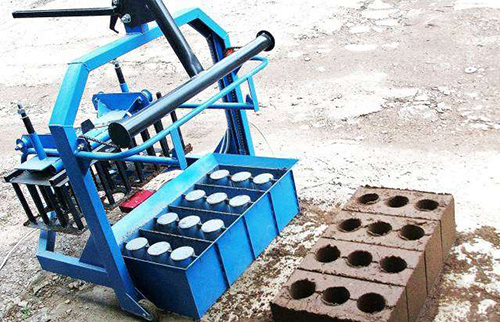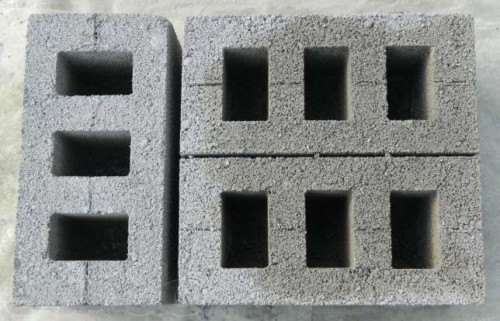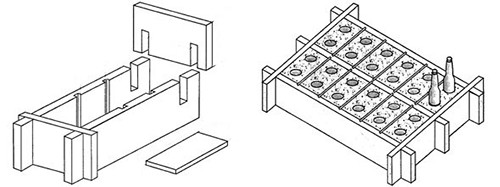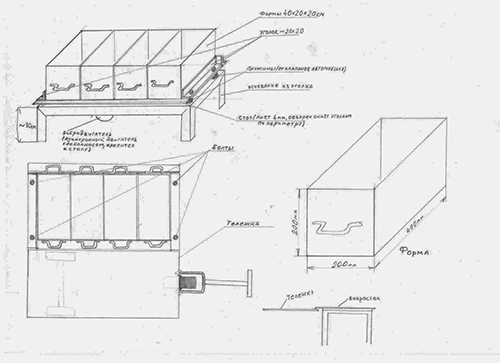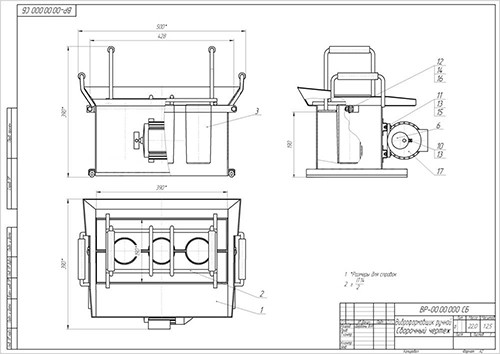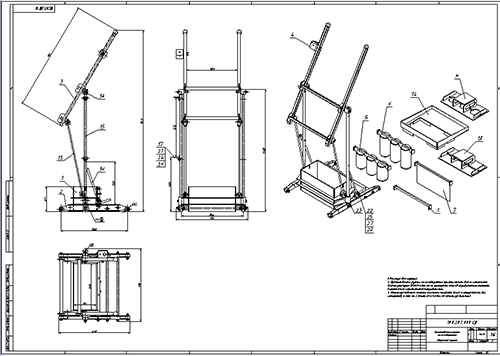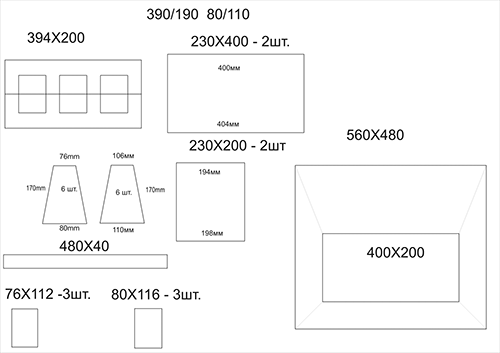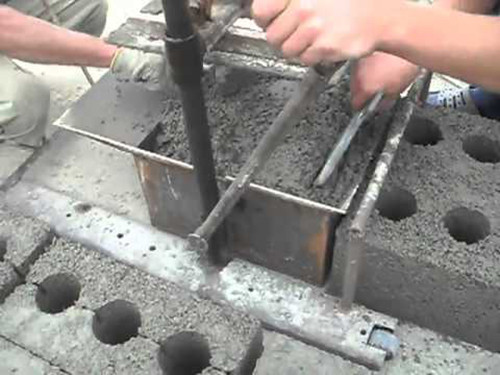The slagoblock has established itself as one of the most convenient and inexpensive materials for the construction of small buildings in 2-3 floors. It is easy enough to install, it weighs little, well keeps warm and saves a lot of time, not to mention money. The last item plays a decisive role, especially if you consider that slag blocks can be made independently at home. Then the economy on construction turns out to be very significant that it can not not to refress the maternity owners. In this article we will tell you how to make shapes for slag blocks with your own hands to get high-quality building material.
Content
Chalkoblok characteristics
Clacoblock is the result of compromising concrete with various impurities using vibration equipment. Construction from this material gives present pleasure, for it is lightweight, has large sizes and clear edges that provide dense adjacent. You can build a box of houses from slagoblocks in just a couple of days, while when using bricks for it will go much more time and strength.
Shlaklocks are hollow and full. The hollows have special holes where the insulating material is then placed. Thus, the block becomes easier and better protects from the cold. They are made from cement, waste of foundry and various fillers, as a result of which the material acquires good heat and sound insulation qualities.
Many economical or just hardworking hosts prefer to make slag blocks with their own hands. This allows not only to reduce construction costs, but also control the strength and operational properties of the blocks by adding different ingredients into the solution.
General requirements
It is possible to engage in the manufacture of slag blocks anywhere - even in its own garage. The main thing is to strictly adhere to technology and find your ideal recipe for making a solution. Standard hollow slag block has dimensions of 39x19x188 mm and three holes in the center.
In order for the material to be high-quality, durable and durable, it is necessary to take large sand for the solution, a domain slag, the cement of the brand is not lower than M400, and the equipment is selected with vibropress. The slags obtained as a result of coal processing are the ideal filler for blocks, but today production volumes decreased due to the active use of gas, so it is not always to get the slag. In this case, a decent alternative will serve Zitobeton, however, its value is significantly higher.
Zitobeton is more expensive than coal slag, but if you compare it with other materials, then the benefit is evident. If it is necessary to produce elementary calculations, it turns out that it is necessary to spend 0.011 cubic meters of cement to produce a single slag block (1: 7 solution). Based on this, one packing of cement is enough to make 36 slag blocks, which has already been a lot.
The recipe "right" solution for slag blocks is very simple - it is necessary to mix 7 parts of the coal slag or the title concrete, 2 parts of the crushed clay, 2 parts of the gravel with a size of 5-10 mm, 1.5 parts of the high-quality cement is not lower than M400 and dilute all three parts of water. Alternatively, the filler can use gypsum, ashes, crumbs, crushed stone, sand, brick and coal working, perlite. By adding various ingredients, you can control the strength, weight and heat efficiency of the material depending on the desired result.
Useful advice: To check, the quality of raw materials for the production of slag blocks, jump out the mixture with hand, squeeze into a lump and throw it into the ground - if the solution is well added and crumbles from the strike of the ground, then the components are mixed in loyal proportions.
If you are going to establish the production of slag block at home, you will have to find your own mixing recipe, because universal methods do not exist. Store the standard formulation described above and vary the number and types of ingredients to your own discretion.
The only thing that should not be changed is the installed form and dimensions of products. The construction uses slag blocks with dimensions of 39x19x20 and 40x20x20. Full-skinned slag blocks have increased strength, so they can be used to erect the foundation, basement floor or basement. Of the hollow materials, warm and soundproof walls are obtained.
Making slagoblocks
In domestic construction, two methods of production of slag blocks are practiced - with the help of homemade wooden matrices or special equipment. Of course, you can buy forms for slag blocks, but if you can easily make them with your own hands, why spend extra money?
Wooden forms
In general, shapes for slag blocks can be made not only of wood, but also from metal (galvanized sheets or other material). However, since the tree is the cheapest and most common material, we will focus on it.
Since the standard size of the slag block is 40x20x20 cm, the form must have the corresponding parameters. A cell where the solution will be poured, consists of the bottom and walls. In order to save material and your own time, you can make a large form with a single frame, separated by crossings forming the cells of the desired dimensions. The width should not exceed 2 m, otherwise it will turn out too cumbersome and uncomfortable. The price of forms for slag blocks in construction stores is often unreasonably overestimated, especially if you consider how easy it is to make it with your own hands from the girlfriend.
Coastings can be made of wood, like the frame itself, but it is better to combine wood and metal. For example, the frame is made from moisture-resistant plywood, and the walls of the cells are made of sheet metal, sliced \u200b\u200bby strips. By the way, the form does not have the bottom, therefore it should be attached to the intermediate elements with the help of stamps, whileking each other. Make a formwork without the bottom and cutting the boards so that it is possible to insert the transverse elements into the longitudinal and fix everything with a single frame (frame). You will have a collapsible design, from which it is easy to remove ready blocks.
The design is placed on a clean flat surface, eliminated by polyethylene film or cellophane. The boards are stained with oil paint so that the solution does not stick to them, and the blocks easily moved away from the form to frozen the mixture.
It remains only to fill the shape of the cooked solution and it is pretty tight. To make a hollow unit, glass bottles are inserted into the solution with a bottom, clean the excess solution and align the block surface. After 5-6 hours, the bottles are removed, and emptiness remains in their place. Dry blocks 24 h, after which they get out of the mold and be stored with stacks.
Homemade Machine "Nonaching"
If you are going to build a big house, several objects or want to start your business for the production of slag blocks, you will have to make a machine, since the form described above will not be able to provide a sufficient amount of finished material.
The optimal option is a machine with vibration engineering, which allows you to produce large volumes of slag blocks, without waiting for the solutions of the solution. This is explained not only by the special principle of the mechanism, but also a more thick consistency of the solution - for this you should make a hard, viscous solution, which gives less shrinkage when drying.
There are 2 methods of mechanized production: using vibrationtol, as in the image above, or with a self-made shape for a slag block equipped with an engine with a displacement of the center of gravity on the shaft. The last way is more convenient because it allows you to immediately do one-piece formed blocks, without turning the form.
We propose to consider the process of assembling the simplest Machine Machine. Below you can see the drawings for the shag block - the machine is a molding matrix without a bottom and a vibrator attached to the sidewall. It also has a handle that helps to easily remove the matrix without damaging the integrity of the raw block.
Making a self-made machine for slag blocks:
- Standards provide specific dimensions of the product, void should be not more than 30%, otherwise the carrier capacity of the block will suffer. To make a matrix, use a sheet metal 3 mm thick or more. Cut a fragment on the shape of a slag block by adding a 5 cm on top for the rambling of the solution. As a result, you should have 2 matrices with a size of 40x25 cm, 2 pieces 20x25 cm, 4 ribs measuring 4x4 cm, a visor 40x15 cm and a pressure element 39.5x19.5 mm.
- Make a cross-cutting form without bottoms from the billets with dimensions of 40x25 and 20x25 cm. Use the welding machine to connect the parts. Brew the seams outside in such a way that the metal does not lead.
- In order for the matrix to be more stable, on the ends, breed the bar cut from thin profile pipes with a diameter of about 8 cm. The length of each workpiece is 25 cm. These billets are located inside the form in one row at an equal distance from the walls of the shape and from each other.
- We weld the segments of the pipes to the matrix and combine with each other with the help of 4x4 cm billets, placing them in the upper part.
- On the perimeter of the base, make rubber upholstery to protect the form from deformations.
- Make an ending apron that will not allow the solution to crumble while filling out the shape.
- At the long side of the almost finished machine, attach the vibrator. You can use a low-power electric motor from an old washing machine as a vibrating device (100-150 W is enough). Make offset by attaching an eccentric on the shaft. The parameters will have to calculate the experimental way, since too large size and weight can create a destructive vibration for the workpiece, and slag blocks will simply fall apart. Secure the motor with bolts, and welcome them to the matrix welding.
- At the vibrating device, attach a visor so that water or cement mortar fall into the engine.
- At the edge of the protective visor, attach the supporting leg - it will give the machine with additional stability, which is simply necessary due to the displaced center of gravity.
- Welcome handle for removing the matrix.
Void in slag blocks can be made of various shapes, but they must be a cone-shaped form so that the matrix easily moved away from a non-frozen solution. Elements for fostering in the void block can be made from round tubes, sharpened on the lathe.
Now you can proceed to the production of blocks. For this, the matrix should be mixed with cold water so that it can be blindly easy to exit without damage. Fill out the form and turn on the vibrator for 5-7 seconds. This time is quite enough to give the mixture to shrink. Add a little more solution, start the motor again and wait for the fit to get on the limiters - this will mean that the molding approached the end. In 5-10 seconds. The matrix can be removed without turning off the device.
Useful Tip: To get a completely smooth front side of the block, lay the casts to dry onto the rubber coating.
Dry blocks from 7 to 20 days depending on the humidity and temperature of the air, as well as raw materials from which they are made. With the help of this simple machine, two people per hour without a special rush will be able to make from 40 to 70 blocks, which, you see, a lot. During the day you can safely make so many blocks as needed for construction, of course, if there is, where they are located to be dried.
The cheapest vibrostanok for the production of slag blocks will cost approximately 10-15 thousand rubles. For this money you can buy several cement bags from other necessary components and make slag blocks, which is enough for a whole garage! The ability to create a shape for slag blocks from undergraduate materials will save you an impressive amount, and the awareness that time and effort is invested in every brick of the house, will make the result of work even more valuable.

